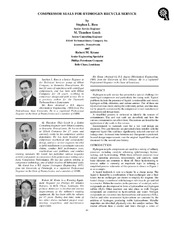| dc.contributor.other | Turbomachinery Symposium (31st : 2002) | |
| dc.creator | Ross, Stephen L. | |
| dc.creator | Gresh, M. Theodore | |
| dc.creator | Kranz, Robert M. | |
| dc.date.accessioned | 2017-10-04T23:57:16Z | |
| dc.date.available | 2017-10-04T23:57:16Z | |
| dc.date.issued | 2002 | |
| dc.identifier.uri | https://hdl.handle.net/1969.1/163323 | |
| dc.description | Lecture | en |
| dc.description | Pg. 85-90 | en |
| dc.description.abstract | Hydrogen recycle service has presented a special challenge for centrifugal compressors and particularly the casing seals. Typical problems include the presence of liquids (condensables and water), hydrogen sulfide, chlorides, and various amines. Few of these are reported on data sheets during the order entry period, and thus may not be properly considered by the compressor or seal manufacturer application and design team. A simplified process is reviewed to identify the sources of contaminants. Dry and wet seals are described, and how the various contaminants can affect them. Precautions are listed for the application of dry seals in this service. Improvements to materials used for a wet seal design are discussed. Two case histories are presented where retrofits with the improved liquid film seal have significantly reduced sour seal oil leakage rates. Increased time between seal changeouts is predicted. Several design improvements over the original liquid film seal are discussed for the second case history. | en |
| dc.format.medium | Electronic | en |
| dc.format.mimetype | application/pdf | |
| dc.language.iso | en | |
| dc.publisher | Texas A&M University. Turbomachinery Laboratories | |
| dc.relation.ispartof | Proceedings of the 31st Turbomachinery Symposium | en |
| dc.subject.lcsh | Turbomachines | en |
| dc.title | Compressor Seals For Hydrogen Recycle Service. | en |
| dc.type.genre | Presentation | en |
| dc.type.material | Text | en |
| dc.identifier.doi | https://doi.org/10.21423/R16W84 | |


